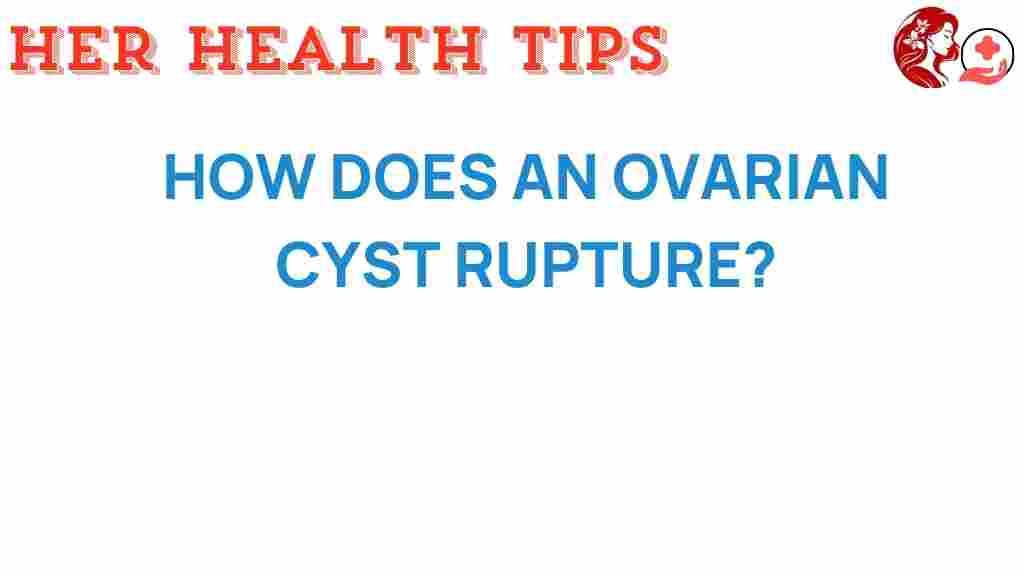The Hidden Dangers: What Happens When an Ovarian Cyst Ruptures?
Ovarian cysts are fluid-filled sacs that develop on the ovaries, and while many women experience them without any complications, the rupture of an ovarian cyst can lead to significant health risks. Understanding the symptoms, potential dangers, and treatment options is crucial for women’s health. This article will delve into the implications of a ruptured ovarian cyst, the associated health risks, and what steps you can take for prevention and proper diagnosis.
Understanding Ovarian Cysts
Ovarian cysts are quite common and often form during the menstrual cycle. Most of the time, they are benign and resolve on their own. However, it’s essential to recognize when they might present complications. Here are some key points about ovarian cysts:
- Types of Ovarian Cysts: Functional cysts (follicular and corpus luteum) are the most common, but others like dermoid cysts and endometriomas can also develop.
- Symptoms: Many women experience no symptoms, but some may experience pelvic pain, bloating, or irregular periods.
- Diagnosis: Ovarian cysts are usually diagnosed through ultrasound or pelvic exams.
What Happens When an Ovarian Cyst Ruptures?
When an ovarian cyst ruptures, it can release its contents into the pelvic cavity, which may lead to various health complications. The effects of a rupture can vary based on the size and type of the cyst. Here’s what you need to know about the potential dangers:
- Pain: A sudden, severe pain is often the first sign of a rupture. This pain may be localized to one side of the abdomen.
- Internal Bleeding: Ruptured cysts can cause internal bleeding, particularly if they are larger or if they involve blood vessels.
- Infection: The release of cyst contents can lead to infection, which may require immediate medical attention.
- Peritonitis: In severe cases, the spilled fluid can cause inflammation of the peritoneum, leading to peritonitis, a serious condition.
Recognizing the Symptoms of a Ruptured Ovarian Cyst
Identifying the symptoms of a ruptured ovarian cyst is critical for timely medical intervention. Common symptoms include:
- Sudden, sharp abdominal pain
- Pelvic pain that may radiate to the back or thighs
- Nausea or vomiting
- Lightheadedness or fainting (indicating potential internal bleeding)
- Changes in menstrual cycle
If you experience any of these symptoms, it is essential to seek medical advice immediately.
Health Risks Associated with Ovarian Cyst Rupture
The health risks of a ruptured ovarian cyst can be serious. Some of the potential complications include:
- Hemorrhage: Large cysts can cause significant bleeding, requiring surgical intervention.
- Infection: The risk of infection increases after a rupture, necessitating antibiotics or further medical treatment.
- Fertility Issues: In some cases, complications from a ruptured cyst can affect fertility, particularly if scarring occurs.
- Chronic Pelvic Pain: Some women may experience ongoing pain following a rupture.
Diagnosis of a Ruptured Ovarian Cyst
If you suspect a ruptured ovarian cyst, your healthcare provider will perform a thorough evaluation. This typically includes:
- Pelvic Exam: A physical examination can help detect tenderness or swelling.
- Ultrasound: Imaging tests like ultrasounds are crucial for visualizing the cyst and any associated fluid in the abdomen.
- Blood Tests: These may be conducted to check for signs of infection or bleeding.
Early diagnosis is vital for effective treatment and management of symptoms.
Treatment Options for Ruptured Ovarian Cysts
The treatment for a ruptured ovarian cyst depends on the severity of the symptoms and the complications that arise. Here are the common treatment approaches:
- Observation: If the rupture is uncomplicated and the symptoms are mild, your doctor may recommend a wait-and-see approach with follow-up visits.
- Pain Management: Over-the-counter pain relievers like ibuprofen or acetaminophen can help manage discomfort.
- Medication: If an infection is present, antibiotics will be prescribed.
- Surgery: In cases of significant internal bleeding or severe infection, surgical intervention may be necessary to remove the cyst and repair any damage.
Preventing Ovarian Cysts and Their Rupture
While not all ovarian cysts can be prevented, certain lifestyle choices may reduce the risk:
- Regular Check-ups: Regular gynecological exams can help detect cysts early.
- Birth Control Pills: Hormonal contraceptives can help regulate the menstrual cycle and may reduce the risk of cyst formation.
- Healthy Lifestyle: Maintaining a balanced diet and regular exercise can enhance overall reproductive health.
When to Seek Medical Advice
It’s crucial to know when to seek medical help regarding ovarian cysts. If you experience any of the following, don’t hesitate to contact a healthcare provider:
- Severe or worsening abdominal pain
- Signs of internal bleeding, such as fainting or severe dizziness
- Persistent nausea or vomiting
- Fever or chills, which could indicate an infection
Prompt medical advice is essential to mitigate potential health risks associated with ovarian cyst rupture.
Conclusion
Understanding the hidden dangers of ovarian cysts, particularly when they rupture, is vital for women’s health. By recognizing the symptoms, knowing the health risks, and seeking timely medical advice, women can manage their reproductive health effectively. Regular check-ups and a proactive approach to health can help in the prevention of ovarian cysts and their complications. For more information on women’s reproductive health, consider visiting this resource or consult with your healthcare provider for personalized advice.
Stay informed, stay healthy, and don’t hesitate to seek help when needed!
This article is in the category Reproductive and created by HerHealthTips Team
